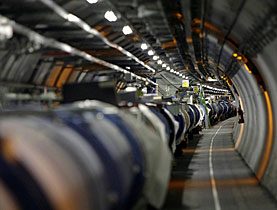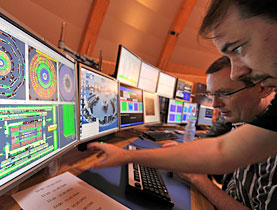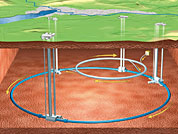Big Bang atom smasher records first proton hits

Scientists at the European Organization for Nuclear Research (Cern) have smashed together proton beams for the first time, following more than a year of repairs.
The results are a big step forward for the world’s largest atom smasher, the Large Hadron Collider (LHC), housed under the Swiss-French border, which has been built to reproduce “Big Bang” conditions.
It is hoped that the experiments will provide clues about the origins of the universe in the next few months as the particle collider moves towards full power.
Monday’s collisions were a side effect of the rapid advances being made by the LHC during its start-up phase, which began on Friday night.
“It’s going very well so far, but we’ve still got a long way to go and we need to keep a sense of perspective about where we are with respect to doing research with the machine,” Cern spokesman James Gillies told swissinfo.ch on Tuesday.
This research, he explained, which will involve the deliberate crashing of protons into each other to learn about make-up of the universe and its tiniest particles, was still scheduled for around the end of January, “perhaps the beginning of February”, next year.
“What we’ve been doing so far is working with what we call the pilot beam, which is a very low-intensity beam of particles. We’ll stay with the pilot beam until we’re convinced that we understand the machine well enough to be able to guide more intense beams safely around without damaging the equipment.”
The LHC was booted up with great fanfare on September 10, 2008, only for an electrical fault to bring the honeymoon to an end nine days later. It took 14 months to repair and add protection systems to the machine before it was restarted on Friday.
“Fantastic era”
Monday’s result was achieved by sending two bunches of subatomic particles whizzing around the 27-kilometre tunnel ring in opposite directions. Collisions were recorded in all four of the main detectors in rooms the size of cathedrals about 100 metres underground.
“Yesterday we had two beams in the machine at the same time for the first time, which generated collisions in the course of the afternoon,” Gillies said. “And then, just to put a bit of icing on the cake, overnight they did the first acceleration in the LHC.”
“This is great news – the start of a fantastic era of physics and hopefully discoveries after 20 years’ work by the international community to build a machine and detectors of unprecedented complexity and performance,” said Fabiola Gianotti, who represents the Atlas particle physics experiment for about 2,000 other scientists.
Physicists hope the collider will help them see and understand other suspected phenomena, such as dark matter, antimatter and supersymmetry.
Cautious
The protons were travelling on Monday at almost the speed of light – 11,000 times a second in each direction around the 27-kilometre tunnel.
So far the machine is operating at 450 billion electron volts (TeV) of energy, which is relatively low compared with its design capability of more than 14 times that. It will soon overtake what is currently the world’s most powerful accelerator, the Tevatron at Fermilab outside Chicago, which operates at one trillion TeV.
Scientists said the discoveries could begin in the first half of next year when the collider reaches 3.5 TeV.
Rolf Heuer, director-general of Cern, said he was being as cautious as a driver would be with the first production model of a new car.
“We’ll never accelerate this the first time with a kick-start to its maximum velocity,” he said, adding that once it is tested out, “we can open windows into new physics and that could happen already next year. It depends on how kind nature is to us”.
Gillies said they now had a programme of at least ten days of rigorous and systematic checks and measurements of the machine before they could increase the intensity of the beams.
“And then once we’re confident we can do that, the objective before Christmas is to provide collision data – still at low energy – to the experiments so they can start doing some serious calibration work,” he said.
“I guess we’re looking at the first serious collisions in a week or so. But the physics starts next year – for us that’s the really big story.”
Thomas Stephens, swissinfo.ch
In the LHC, high-energy protons in two counter-rotating beams are smashed together to search for exotic particles.
The beams contain billions of protons. Travelling just under the speed of light, they are guided by thousands of superconducting magnets.
The beams usually move through two vacuum pipes, but at four points they collide in the hearts of the main experiments, known by their acronyms: ALICE, ATLAS, CMS, and LHCb.
When operational, the detectors see up to 600 million collision events per second, with the experiments scouring the data for signs of extremely rare events such as the creation of the so-called God particle, the yet-to-be-discovered Higgs boson.


In compliance with the JTI standards
More: SWI swissinfo.ch certified by the Journalism Trust Initiative













You can find an overview of ongoing debates with our journalists here . Please join us!
If you want to start a conversation about a topic raised in this article or want to report factual errors, email us at english@swissinfo.ch.